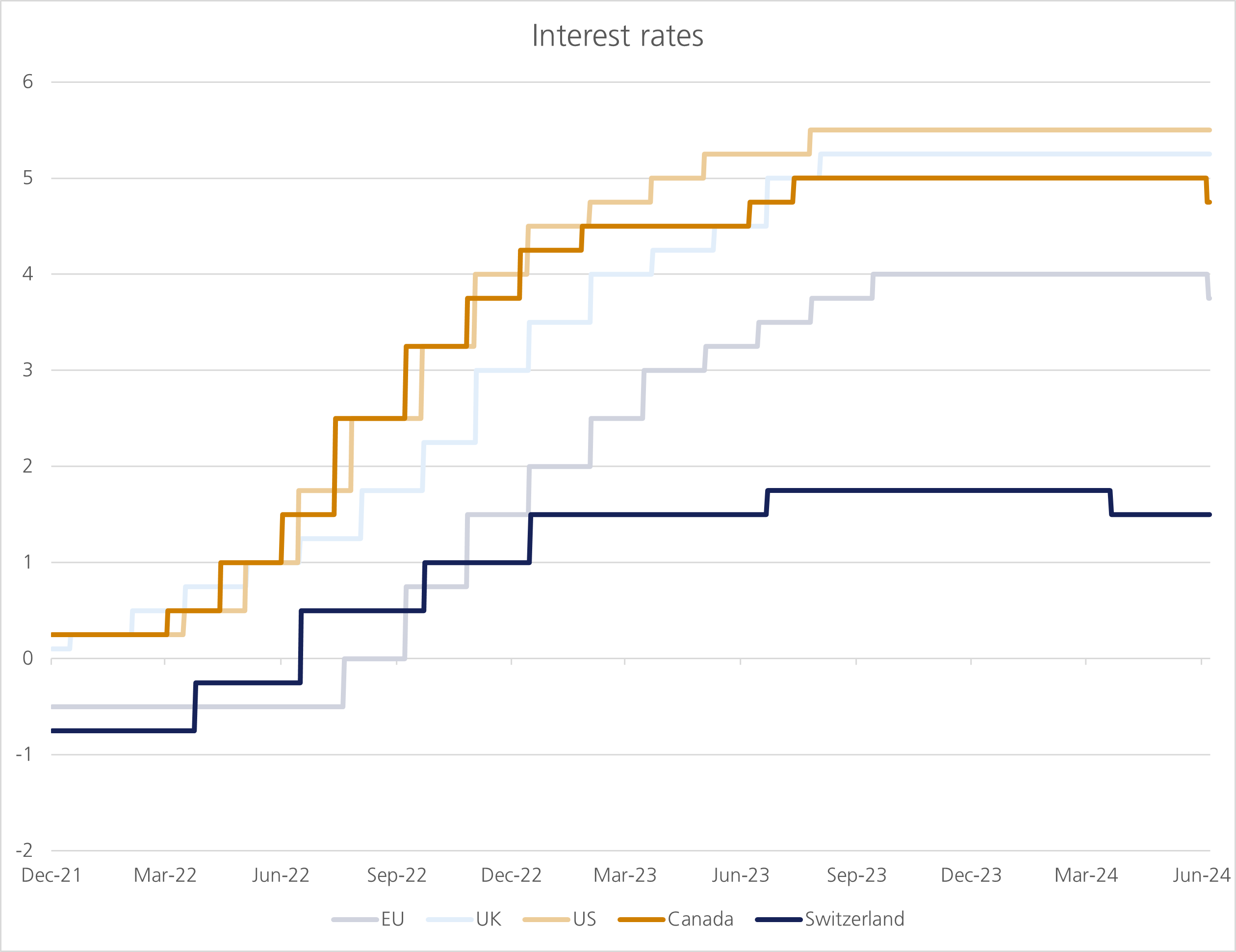
Coming into 2024, investors expected central banks to embark on significant rate cutting cycles, but stickier inflation and a resilient growth outlook pushed these expectations further out. From of all the major developed market central banks, the European Central Bank (ECB) provided the clearest signal that it sought to cut interest rates in short order. This is a luxury not available to the Federal Reserve (Fed) or the Bank of England (BoE), as inflation concerns are greater, resulting in the number of anticipated rate cuts in the US and UK declining throughout the year.
On Thursday, the ECB cut interest rates by 0.25%, marking the first decline in five years amid declining inflation and a sluggish economy. This brings the Eurozone’s main deposit rate from 4% to 3.75%.
As we marked the 80th anniversary of D-Day on 6th June, another war wages on Europe's borders following Russia’s invasion of Ukraine over two years ago. This military shock sent energy and food prices up, and the ensuing inflation led ECB to accelerate their hiking cycle. The ripple effects are still felt today, but the impact is waning. European reliance on Russian gas and the subsequent rationing and sanctions dealt a heavy blow to the German manufacturing model. Consequently, its economy has been in the doldrums for some time. Germany saw its economy shrink in the fourth quarter of last year and has only seen a modest uptick since. Economists now forecast that structural weakness will continue to weigh on Germany’s recovery. Meanwhile, southern Europe is having its time in the sun with Spain growing at healthy pace.

Europe’s uneven recovery led the ECB to focus on growth, as inflation concerns have abated. What remains unknown is how many rate cuts market participants can expect this year. Interest rates will not fall as fast as they went up, and market participants expect the ECB will cut rates two more times in 2024.
In Thursday’s press conference, ECB President Christine Lagarde said, “despite the progress over recent quarters, domestic price pressures remain strong as wage growth is elevated, and inflation is likely to stay above target well into next year”.1 She underscored how the ECB will continue to be data dependent, and will analyse the inflation outlook, underlying inflation and the strength of transmission of monetary policy before proceeding with further cuts.
The meeting had little effect on markets given the rate cuts were so well telegraphed.
Lagarde strived for strategic ambiguity given the potential for shocks as European Parliamentary elections are ongoing and broader geopolitical tensions.
The ECB’s move on Thursday follows similar rate cuts made by central banks in Switzerland, Sweden and Canada this year. It is likely the BoE will be the next major developed market central bank to cut rates, now expected in September, which would be welcomed and should help increase economic momentum. But the path to cutting interest rates is far from straightforward. Rising differences between interest rate across regions can weaken currencies, leading to imported inflation, a topic we explored in our Brief “European central banks: stuck in the middle?”. Europe also must contend with ongoing fragility in energy markets, as the continent is and will remain a net importer of natural gas and petroleum oil.2
While the starting gun on the rate cutting cycle has started, regional differences will result in a widening gap between central banks. Given that the Fed’s sphere of influence, this will mean central banks elsewhere will adopt a cautious approach and favour ambiguity over clear forward guidance.
[1] ECB, https://www.ecb.europa.eu/press/pr/date/2024/html/ecb.mp240606~2148ecdb3c.en.html
[2] Europa, https://ec.europa.eu/eurostat/web/products-eurostat-news/w/ddn-20240322-2
This communication is provided for information purposes only. The information presented herein provides a general update on market conditions and is not intended and should not be construed as an offer, invitation, solicitation or recommendation to buy or sell any specific investment or participate in any investment (or other) strategy. The subject of the communication is not a regulated investment. Past performance is not an indication of future performance and the value of investments and the income derived from them may fluctuate and you may not receive back the amount you originally invest. Although this document has been prepared on the basis of information we believe to be reliable, LGT Wealth Management UK LLP gives no representation or warranty in relation to the accuracy or completeness of the information presented herein. The information presented herein does not provide sufficient information on which to make an informed investment decision. No liability is accepted whatsoever by LGT Wealth Management UK LLP, employees and associated companies for any direct or consequential loss arising from this document.
LGT Wealth Management UK LLP is authorised and regulated by the Financial Conduct Authority in the United Kingdom.